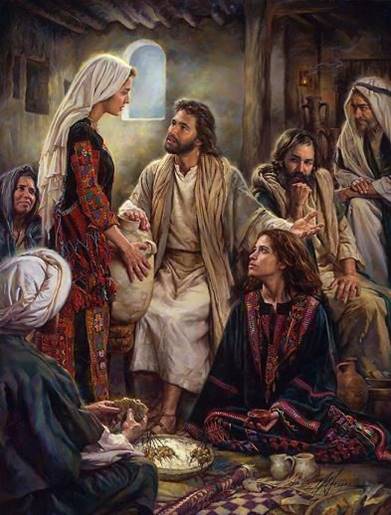
A Fresh Perspective on Martha and Mary by Barbara Farris
The well-known story of Jesus’ relationship with sisters Martha and Mary has a caused a great deal of consternation for worker bee women like me. I have always felt that Martha’s frustration and resulting outburst were completely justified. Who wouldn’t resent being saddled with all the work while their sister hung out with the guys around the Teacher? Why would Jesus teach about serving others and then rebuke Martha for doing just that, and worse, defend Mary? I came away from this story feeling like a rejected ‘Martha’ whose gifts weren’t valued or appreciated. But then I heard the story explained in a different light. What if Jesus wasn’t criticizing Martha, but instead offering her a radical invitation to know him better?
To fully grasp the significance of Jesus’ interactions with these sisters, we must understand the expectations of a 1st century Jewish woman living in Roman-occupied Israel. Women were largely segregated from men in public, private, and religious life. They were expected to remain at home managing their households and raising their children. Social outlets were generally restricted to attending the local synagogue, weddings, funerals, and visiting relatives.
Martha and her siblings lived in Bethany, located on the pilgrimage route from Galilee in the north to Jerusalem in the south, so Jesus passed through Bethany many times journeying to Jerusalem. After he began his public ministry, Martha opened her home to Jesus and his disciples on one of these trips (Luke 10:38-42). The reference, “opened her home” implies that she was not married and was the head of the household. Martha served the large group assembled in her home, and she wasn’t at all happy about Mary’s choice to shirk her expected role and hang out with Jesus instead.
It wasn’t just that Mary wasn’t helping; she was seated at Jesus’ feet, a position reserved for the rabbi’s students. It was improper for a woman to join the men, and even worse that she was seated among his disciples! Martha, overflowing with righteous indignation, confronted Jesus in front of the entire group, “Lord, don’t you care that my sister has left me to do the work by myself? Tell her to help me!” (Luke 10:40). Now who’s stepped out of her cultural ‘box’? Martha has confronted the rabbi, a definite no-no, and in front of a room full of men. Imagine the collective gasp! How is Jesus going to handle this major affront?
He looks at her, calls her by her name (very counter-culture!), and acknowledges her distress: “Martha, Martha, you ARE worried and upset about many things….” Then, he gently reminds her to reconsider her priorities, “…but few things are needed—or indeed only one. Mary has chosen what is better, and it will not be taken away from her.” Jesus affirmed Martha’s distress and then showed her a better way. It is not recorded that he invited Martha to sit down and join them, but his invitation is strongly implied. Jesus wanted Martha, and us, to know that spending time with him is more important than our service for him.
Did Martha learn from this experience? Fast-forward to the death of their brother Lazarus. In faith, they sent for Jesus to minister to their seriously ill brother, but he did not come. When Jesus finally did arrive, Lazarus had been in the tomb for four days. Even so, after initially confronting Jesus for not healing her brother, grieving Martha affirmed, “Yes, Lord, I believe that you are the Messiah, the Son of God, who is to come into the world” (John 11:27). Even before he raised her brother from the dead, Martha knew who Jesus was because she had spent quality time with Him.
But her story is not quite over. It is now the week before the Passover celebration. Jesus has stopped over in Bethany to spend time with his friends, and enjoy a large dinner given in his honor. Once again, Martha is serving and Mary sits at Jesus’ feet. But this time is different. Martha isn’t stressed and complaining. Mary isn’t in the posture of a pupil but as a worshipper. She washes Jesus’ feet with expensive perfume and dries them with her hair. It was excessively extravagant to wash Jesus’ feet with perfume when water was available, but Martha doesn’t protest! Could Martha have been in full agreement with Mary’s actions? Is it possible that the sisters agreed ahead of time to do this? We aren’t told, but I like to believe that they did. They loved Jesus because he was the promised Messiah. Additionally, they owed him a huge debt of gratitude, because he had restored their brother’s life. They undoubtedly knew that Jesus was in grave danger as he entered Jerusalem that year for Passover. And so, Martha served, Mary worshipped, and the two of them together present a beautiful picture of how we are to relate to our Lord and Savior. We express our love and devotion to Jesus by spending time at his feet and by serving others in his name.
Now, instead of cringing at the story of Martha and Mary, I am delighted that there’s no contradiction between what Jesus said to Martha and what he was teaching his followers. He came as a servant and taught us to be servants, too (Luke 22:26-27, John 12:26). However, our first priority must always be to spend time with him so that we know him and recognize his voice as he gives direction and purpose to our service.
Barbara is a retired public school teacher who now enjoys donating her time and skills as a volunteer reading buddy in a public school and adult ESL teacher. She is also blessed to live near her adult daughters and their families and enjoys spending time with them. Her hobbies include traveling and quilting.



